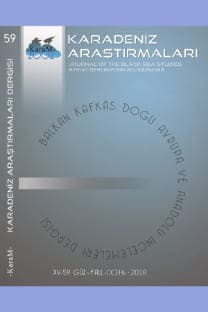‘Kargaşa’ Esnasında Tarih Yazmak: Geç Roma Müverrihlerinde İskit ve Hun Etnonimlerinin Kullanımı Üzerine
Batı Avrasya’da Hun yükselişinin oluşturduğu dalgalar, Roma İmparatorluğunu da içine çekecek bir ‘karmaşa’ ortamı oluşturmuştur. Olayları nakletmeye çalışan Roma müverrihleri**, Kavimler Göçünü’de barındıran bu süreci olabildiğince takip edilebilir kılmışlardır. Ammianus’dan Zosimus’a bu yazarların metinleri tarandığında Hunlara değindikleri satırlarda, bilhassa İskit ve diğer etnonimleri kullanımındaki tercihlerinde, hem onları nasıl algıladıklarının hem de bu kargaşa ortamının izlerinin bir yansıması ortaya çıkmaktadır.
Anahtar Kelimeler:
Geç Roma tarihyazımı, Geç Roma tarihyazımı terminolojisinde kuzeyli –barbarlar, İskit-Hun-Got adları.
Writing History during the Chaos: Application of the Ethnic Names Scythian and Hun by the Late Roman Historians
The ripple waves of the rose of the Huns in western Eurasia created an atmosphere of confusion, taking the Roman Empire in. In their attempts to narrate the events, Roman historians made it possible to follow this process, which includes the Völkerwanderung, to a large extent. When the texts of these authors, from Ammianus to Zosimus, are scanned, it is seen that the terms they choose in referring to the Huns, especially the Scythians and other ethnonyms, reveal how these authors perceived the Huns and how this era of conflict was reflected in their writings.
Keywords:
Late Roman historiography, northern barbarians in the terminology of the late Roman historiography, ,
___
- AMMİANUS Marcellinus, Res Gestae, ed. ve ter. için bkz. Rolfe 1956; ter. için ayrıca bkz. Lukomskiy 1994. BLOCKLEY R. C. (1983), The Fragmentary Classicising Historians of the Later Roman Empire II Eunapius Olympiodorodus Priscus and Malchus text translation and historiographical notes, ARCA Classical and Medieval Texts, Papers and Monographs 10, Liverpool.Destunis 1860, DESTUNİS G. (1860), Skazaniya Priska Panayskovo, Sn. Petersburg EUNAPIUS Sardis, Fragman XLII, ed. ve ter. için bkz. Blockley 1983. GORDON C. D. (1961), The Age of Attila, New York. HERODOTUS, Historiae, ter. için bkz. Rawlinson 1941. HIERONYMUS Eusebius Sophronius (Jeremo), Chronographia, ter.: http:// www.tertullian.org/fathers/jerome_chronicle_03_part2.htm (Nisan 2013) IORDANES (Jordanes), Getica, Ed. ve ter. için bkz. Skrjinskaya 2001. LATIŞEV V. V. (1948), “İzvestiya drevnih pisatiley o Skifii i Kavkaze”, Vestnik Direvniy İstorii, 1948/ 4: 245-267. LUKOMSKİY L. Yu. (1994), Ammian Martsellin Rimskaya istoriya, Antiçnaya biblioteka, Sn. Petersburg. ODB III: KAZHDAN Alexander P vdğ. ed. (1991), The Oxford Dictionary of Byzantium, c. III, New York-Oxford. OLYMPIODORUS, Fragman XIX ve XXVII. ed. ve ter. için bkz Blockley 1983; ter. için bkz. Skrjinskaya 1956. OROSIUS Pavlus, Historia Adversum Paganos, ter.: TYULENEV V. M. (2009), Pavel Oroziy İstoriya protiv yaziçnikov Pirivod s latinskavo kommentarii i ukazatel, Sn. Petersburg; ayrıca FEAR A. F. (2010), Orosius Seven Books of History Against the Pagans, Liverpool. PHILOSTORGİUS, Historia Ecclesiastica, ter.: Amidon P. R. (2007), Philostorgius Church History. PLRE II: MARTINDALE, J. R. ed. (1980), The Prosopography of the Later Roman Empire, c. II (395–527), Cambridge. PRISCUS Fragman II ve XLIX , ed. ve ter. için bkz. Blockley 1983, ter. için ayrıca Latışev 1948. PROSPERUS Aquitanus, Epitoma Chronicon, ter. Murray A. C. (2000), From Roman to Merovingian Gaul, ss. 62-75, Peterborough. RAWLİNSON George (1941), Heredot Tarihi, İstanbul (ter. Ömer Rıza Doğrul) ROLFE J. C. (1956), Ammianus Marcellinus I-III, Loeb, Londra. SKRJİNSKAYA E. Ç. (1956), “‘İstoria’ Olimpiodora”, Vizantiyskiy vremennik VIII: 233-277.
- ISSN: 2536-5126
- Yayın Aralığı: Yılda 4 Sayı
- Başlangıç: 2004
- Yayıncı: Osman Karatay
